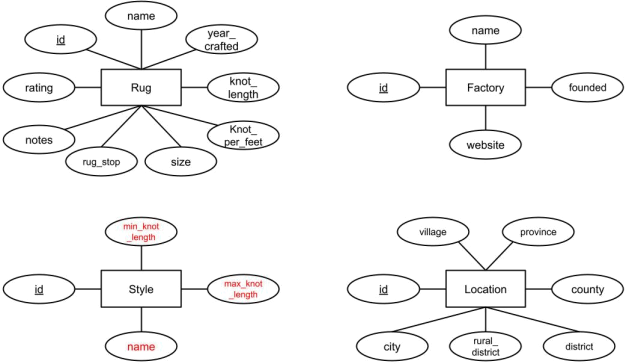Hello, dear friend, you can consult us at any time if you have any questions, add WeChat: daixieit
COMP3311 24T2
Assignment 1
Database Systems
Data Models for RugDB
Last updated: Friday 14th June 7:37am
Most recent changes are shown in red ... older changes are shown in brown.
[Assignment Spec] [Database Design] [Examples] [Testing]
Introduction
This gives both an overview and a detailed description of the rug database for this assignment. The overview is expressed as an ER diagram; the detail are given via an annotated SQL schema.
ER Model of RugDB
Most entities have an ID field as the primary key. We wouldn't normally do this at the ER level, but none of the entities seemed to have obvious and compact primary keys.
Relationships between entities
Notes:
every rug is crafted at some factory
several factories may produce the same rug
every rug is associated to one style
sometimes we may not know the materials in a rug
we know at least the province where each factory is located

Attributes of entities

SQL Schema for RugDB
Notes:
n:m relationships are implemented by a new table
1:n relationships are implemented by a FK attribute
the materials class hierarchy is implemented using a single-table mapping
new types and domains aim to provide more readable table definitions
schema.sql
-- PersianRug Schema
-- Original version: John Shepherd (Sept 2021)
-- Current version: Armin Chitizadeh (June 2024)
--
-- To keep the schema a little shorter, I have ignored my usual
-- convention of putting foreign key definitions at the end of
-- the table definition.
--
-- Some general naming principles:
-- max 10 chars in field names
-- all entity tables are named using plural nouns
-- for tables with unique numeric identifier, always call the field "id"
-- for cases where there's a long name and a short name for something,
-- use "name" for the short version of the name (typically for display),
-- and use "longname" for the complete version of the name (which might
-- typically be used in lists of items)
-- for foreign keys referring to an "id" field in the foreign relation,
-- use the singular-noun name of the relation as the field name
-- OR use the name of the relationship being represented
--
-- Null values:
-- for each relation, a collection of fields is identified as being
-- compulsory (i.e. without them the data isn't really usable) and
-- they are all defined as NOT NULL
-- reminder: all of the primary keys (e.g. "id") are non-NULL
-- note also that fields that are allowed to be NULL will need to be
-- handled specially whenever they are displayed e.g. in a web-based
-- interface to this schema
--
-- Types/Domains
create type MaterialType as enum ('pile', 'warp', 'kilim', 'weft');
create type RugStopType as enum ('leather', 'faux', 'bonded', 'plastic');
create domain YearValue as integer check (value between 1000 and 2100);
create domain SquareFeet as integer check (value > 0);
create domain URLvalue as text check (value like '%.%'); -- weak check
create domain KnotLenghValue as real check (value between 0.0 and 100.0);
create domain KnotPerFootValue as integer check (value between 0 and 200);
-- Tables
create table Locations (
id integer, -- would normally use serial
province text not null, -- must at least know province
county text, -- geographic region of a country used for administrative or other purposes in some nations
district text, -- area consisted of several cities and villages
rural_district text, -- area consisted of mainly villages
city text, -- larger factories are located at cities
village text, -- family small business are mostly located from villages
primary key (id)
);
create table Styles (
id integer, -- would normally use serial
name text not null unique, -- name of style (e.g. Nain, Gol Henai)
min_knot_length knotLenghValue not null,
max_knot_length knotLenghValue not null,
primary key (id),
constraint minmax check (min_knot_length <= max_knot_length)
);
create table Materials (
id integer, -- would normally use serial
itype MaterialType not null,
name text not null,
primary key (id)
);
create table Factories (
id integer, -- would normally use serial
name text not null unique,
founded YearValue,
website URLvalue,
located_in integer not null references Locations(id),
primary key (id)
);
create table Rugs (
id integer, -- would normally use serial
name text not null,
year_crafted YearValue,
style integer not null references Styles(id),
knot_leng KnotLenghValue not null,
knot_per_foot KnotPerFootValue,
rug_stop RugStopType,
size SquareFeet,
notes text,
rating integer check (rating between 0 and 10),
primary key (id)
);
create table Contains (
rug integer references Rugs(id),
material integer references Materials(id),
primary key (rug,material)
);
create table Crafted_by (
rug integer references Rugs(id),
factory integer references Factories(id),
primary key (rug,factory)
);



